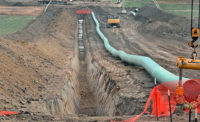With more than 70% of the U.S. power grid at least 25 years old, and a doubling of the transmission capacity needed by 2030, the Biden administration has made $13 billion in financing available to states, utilities and others for upgrades.
Officials termed it the first down payment on more than $20 billion in funding to support modernization and build-out of long-distance, high-voltage transmission and distribution lines.
“These federal investments will unlock billions of dollars of state and private sector capital,” the administration said Nov. 18 in opening the application period for three types of funding included in the $10.5-billion Grid Resilience and Innovation Partnership Program that was included in the 2021 infrastructure law.
Concept papers are due Dec. 16 for $3 billion available in smart grid grants that focus on increased capacity, efficiency and reliability. Projects would enable integration of electric vehicles, renewable energy and other grid devices at the transmission and distribution levels. The program requires a 50% minimum cost share and is open to state and local governments, tribes and others.
The $5-billion grid innovation program is available to fund innovative approaches to transmission, distribution and regional reliance with an eye toward reliable operation and improved resilience. It is open to states individually or in pairs, as well as to tribes, public utility commissions and local governments. Concept papers are due Jan. 13.
The grid resilience utility and industry grant program includes $2.5 billion to support modernization to reduce effects of extreme weather and natural disasters in power disruption, the U.S. Dept. of Energy's grid development office said.
Electric grid operators and generators and transmission owners or operators are eligible. as are others. The program includes a small utility set-aside. Concept papers are due Dec. 16.
Another $2.5 billion is available under the Transmission Facilitation Program—a revolving fund to provide support to overcome financial hurdles in developing large new transmission lines and upgrading existing ones.
DOE will use capacity contracts to purchase up to 50% of the maximum capacity of projects to increase confidence of additional investors and reduce project developer risk in potentially underbuilding or undersizing needed transmission capacity projects, the agency said.
The program "is designed for projects that would otherwise not be constructed without support,” DOE said.
Eligible projects include new or replacement transmission lines of at least 1,000 MW, projects of at least 500 MW in an existing corridor and connection of an isolated microgrid in Alaska, Hawaii or a U.S. territory to an existing system.
Submissions are due Feb. 1 for the first phase.
Grid Risks
Meanwhile the North American Electric Reliability Corp. (NERC), a not-for-profit regulatory authority that assures grid reliability and security, in mid-November identified areas of concern in its latest review of generation and transmission resources to meet projected winter peak demands.
“A large portion of the North American bulk power system is at risk of insufficiency in electricity supplies during peak winter conditions,” NERC said, citing higher peak demand, inadequate generator weatherization, and fuel supply and natural gas infrastructure risks, particularly in Texas and in parts of the large multi-state Mid-continent transmission region.
The risk in Texas of a significant number of generator-forced outages in extreme and prolonged cold temperatures continues to threaten reliability where generators and fuel supply infrastructure are not designed or retrofitted for such conditions, the report said.
The availability of two coal-fired units in the state could be affected by the U.S. Environmental Protection Agency’s decision by year end regarding compliance with hazardous coal ash disposal regulations.
The capacity of natural gas transportation infrastructure could be constrained when cold temperatures cause peak demand for both electricity generation and consumer space-heating needs, the NERC report said
Fuel supplies are an ongoing winter reliability concern, NERC said, adding that an inadequate supply of distribution transformers also could slow restoration efforts after winter storms this year.
Transformer production has not kept pace with demand, with a survey by the American Public Power Association finding that many utilities have low levels of emergency stocks that are used to respond to natural disasters.
“Electricity customers may experience delayed restoration of power following storms as crews must work to obtain new equipment,” its report said.




Post a comment to this article
Report Abusive Comment